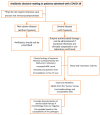Antibiotics Used for COVID-19 In-Patients from an Infectious Disease Ward
- PMID: 36671351
- PMCID: PMC9854891
- DOI: 10.3390/antibiotics12010150
Antibiotics Used for COVID-19 In-Patients from an Infectious Disease Ward
Abstract
Background: although the prevalence of bacterial co-infections for COVID-19 patients is very low, most patients receive empirical antimicrobial therapy. Furthermore, broad spectrum antibiotics are preferred to narrow spectrum antibiotics. Methods: in order to estimate the excess of antibiotic prescriptions for patients with COVID-19, and to identify the factors that were correlated with the unjustified antibiotic usage, we conducted an observational (cohort) prospective study in patients hospitalized with COVID-19 at the National Institute for Infectious Diseases “Prof. Dr. Matei Bals”, Bucharest, on an infectious disease ward, from November 2021 to January 2022. To evaluate the prevalence of bacterial co-infection in these patients, all positive microbiology results and concomitant suspected or confirmed bacterial co-infections, as documented by the treating doctor, were recorded. The patients were grouped in two categories: patients who received antibiotics and those who did not receive antibiotics, justified or not. Results: from the 205 patients enrolled in the study, 83 (40.4%) received antibiotics prior to being admitted to the hospital. 84 patients (41.0%) received antibiotics during their hospitalization; however, only 32 patients (15.6%) had signs and symptoms suggestive of an infection, 19 (9.3%) presented pulmonary consolidation on the computed tomography (CT) scan, 20 (9.7%) patients had leukocytosis, 29 (14.1%) had an increased procalcitonin level and only 22 (10.7%) patients had positive microbiological tests. It was observed that patients treated with antibiotics were older [70 (54−76) vs. 65 (52.5−71.5), p = 0.023, r = 0.159], had a higher Charlson index [4 (2−5) vs. 2 (1−4), p = 0.007, r = 0.189], had a severe/critical COVID-19 disease more frequently [61 (72.6%) vs. 38 (31.4%), p < 0.001, df = 3, X2 = 39.563] and required more oxygen [3 (0−6) vs. 0 (0−2), p < 0.001, r = 0.328]. Conclusion: empirical antibiotic treatment recommendation should be reserved for COVID-19 patients that also had other clinical or paraclinical changes, which suggest a bacterial infection. Further research is needed to better identify patients with bacterial co-infection that should receive antibiotic treatment.
Keywords: COVID-19; antibiotics; bacterial co-infection.
Conflict of interest statement
The authors declare no conflict of interest.
Figures



References
-
- Coronavirus 2019-nCoV, CSSE, Coronavirus 2019-nCoV Global Cases by Johns Hopkins CSSE. [(accessed on 28 November 2022)]. Available online: https://gisanddata.maps.arcgis.com/apps/opsdashboard/index.html#/bda7594....
-
- Martín-Loeches I., Sanchez-Corral A., Diaz E., Granada R.M., Zaragoza R., Villavicencio C., Albaya A., Cerdá E., Catalán R.M., Luque P., et al. Community-acquired respiratory coinfection in critically ill patients with pandemic 2009 influenza A(H1N1) virus. Chest. 2011;139:555–562. doi: 10.1378/chest.10-1396. - DOI - PubMed
-
- Rice T.W., Rubinson L., Uyeki T.M., Vaughn F.L., John B.B., Miller R.R., Higgs E., Randolph A., Smoot B.E., Thompson B.T. Critical illness from 2009 pandemic influenza A virus and bacterial coinfection in the United States. Crit. Care Med. 2012;40:1487–1498. doi: 10.1097/CCM.0b013e3182416f23. - DOI - PMC - PubMed
LinkOut - more resources
Full Text Sources
Miscellaneous

